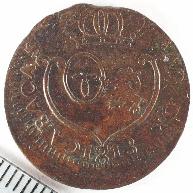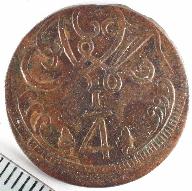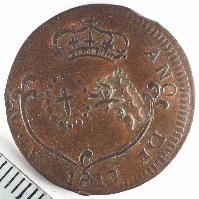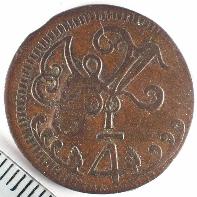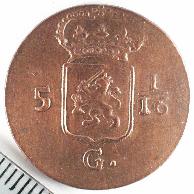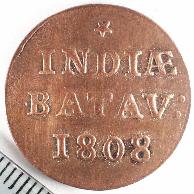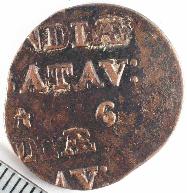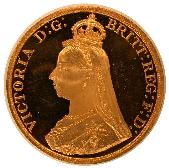Chatter
archive
also available
| Chicago Coin Club |
|---|
| Volume 49 No. 5 |
May 2003 |
|---|
Speaker's Wor[l]d
300 Years of Portraits of the Caesars as Shown on Sestertii Coinage
Presented by
John Wright
to our April 9, 2003 meeting.
Although many know of John as a collector of early American copper coins
for over 50 years,
he has also been interested in other large copper-based coins:
Swedish plate money,
Russian 10 kopecks,
Ptolemaic (Egyptian),
and the Roman sestertius.
Drawing upon his 20 years of experience with the sestertius,
John's presentation consisted of showing a slide of a nice sestertius picturing a Roman
emperor while desribing that emperor, his life and rule, and numismatic significance.
However, it soon became apparent that 300 years would not fit into one night,
so it was agreed that John must return to finish the topic with a Part II.
The sestertius, the largest struck bronze coin
of the Roman Empire,
was struck from 36BC to 268AD.
Although Julius Caesar had silver coins struck with his own portrait,
the only portrait bronze of Julius
was a propaganda coin struck by Octavian in 36BC, after Julius' deification.
This piece has the head of Julius inscribed "Julius the God"
on one side and the head of Octavian inscribed "Son of the God"
on the other.
After Julius' muder in 44BC, his will left his fortune and legacy
to his 19-year old adopted grand-nephew Octavian.
Groomed from childhood for leadership,
Octavian met and overcame all challenges.
First, all of Julius's assassins were executed within two years;
then the other members of the ruling Triumvirate were removed.
Proclaimed Caesar (now a title, not a name) in 27BC,
he took the name Augustus.
He had coins struck in gold, silver, and bronze;
the sestertius was the unit of value,
and the only silver coin (denarius) was worth 20 sestertii.
Although mostly silver coins survive, the bronze coins were the coins of commerce.
Born in 42BC, Tiberius was four when his mother divorced to marry Octavian;
he became Caesar at age 56 on the death of Augustus.
Totally lacking in Augustus' charisma,
after 12 years of thwarted and imagined assassination attempts
he removed himself to the island of Capri where he remained for his last 11 years.
The only portraint sestertius of Tiberias was struck under Augustus
shortly before Augustus' death;
the inscriptions on this piece have the letter bottoms near the rim
instead of the usual letter tops.
The many sestertii struck under Tiberias featured scenes.
Caligula was the great nephew of Tiberias and the great grandson of Augustus.
He was pictured addressing his troops on the displayed sestertius.
His excesses are well known even today.
After less than four years, his personal bodyguards murdered him,
his wife, and their baby.
Claudius, as the only male of the Julian house to survive Caligula's purges,
was proclaimed Caesar by the Praetorians (the assassins) and the Senate concurred.
Claudius was the first Caesar to pay the Praetorians
a substantial donative or accession bonus.
Following the execution of his wife for her part in an assassination plot,
he recalled from exile his niece Agrippina Junior (sister of Caligula), and married her.
She persuaded Claudius to name her son Nero as successor,
then she poisoned Claudius.
Nero was almost 17 when he became Caesar in 54AD.
He poisoned his step brother Britannicus (son of Claudius),
then had his mother killed five years later.
Wholesale treason trials and executions of many Senators
led the Senate to proclaim Nero an "Enemy of the State".
He committed suicide in 68AD rather than be arrested and flogged to death.
His end did not bring an end to the run of unfortunate emperors,
but it did mark the start of a turbulent period where no emperor
lasted long in office.
Galba had the support of the Senate, which ratified his principiate on Nero's death.
The empire was in dire need of a tightened budget, and Galba did what was needed.
However, his rufusal to pay a donative gave Otho, a spurned successor, an opening;
at his urgings, the Praetorians killed Galba and his designated heir Piso
after a reign of only seven months.
There were to be three more rulers in 69AD.
While Otho had plotted against Galba,
the troops of Vitellius in Germany proclaimed him as Emperor.
Vitellius' troops marched on Rome and defeated Otho's legions;
Otho's three-month reign ended with his suicide.
The only bronze coin bearing Otho's portrait was from Antioch,
which was slow to hear of Otho's demise.
Vitellius was a friend of each of the previous eight Caesars,
but he also was a gambler, a sybarite, a glutton, a bulimic,
and militarily inexperienced.
Galba had appointed him governor of Lower Germany to get him out of Rome.
Two months after Otho's death,
the Judean, Egyptian, and Syrian legions proclaimed Vespasian
as Caesar in opposition to Vitellius.
Vitellius tried to abdicate, but was not permitted to do so.
His disorganized and leaderless armies were soundly defeated,
and Vitellius was brutally murdered by his own soldiers.
His short reign was the origin of today's images
of the orgies and gluttony of the Roman Empire.
Vespasian was a military commander,
distinguished for his actions in the invasion of Britain under Claudius.
He had been governor of Judea when the first Jewish revolt broke out in 66AD,
but the revolt had been mostly put down when his troops proclaimed him Caesar in 69AD.
He was 60 when he became Caesar,
and spent the next ten years restoring the empire from the ravages of 69AD.
Titus, the able son of Vespasian, completed the wrap-up of the Jewish revolt in 70AD
by leveling the Temple in Jerusalem where the Zealots had fortified themselves.
He succeeded his father in 79AD and died two years later at age 41
from a fast moving illness.
During Titus' short reign the Colosseum was completed and first used;
also Mount Vesuvius erupted, burying Pompeii and Herculaneum.
Domitian, the 12th Caesar, was 29 when his brother Titus died in 81AD.
Though he proved himself an able administrator,
he had a great personal need for absolute authority.
Executions for "high treason" ran rampant during his 15 year reign,
as nobles and Senators by the hundred died at his order.
A palace plot involving his wife eventually succeeded
in Domitian's murder in 96AD.
Nerva was appointed Caesar the same day as Domitian's murder,
and was likely involved in that plot.
He focused on civil restoration, not on military feats
during his 16 month reign.
History records him as the first of the five "good emperors",
as he began the practice of succession by merit rather than by blood.
Trajan was a skilled and ambitious military administrator.
His personal goal was to surpass the conquests of Julius,
and under his 20-year reign the borders of the empire
reached their greatest extent.
A common blessing in the later empire was "May you be
as lucky as Augustus and as good as Trajan."
His reign began the hundred-year "golden age of Rome."
Hadrian, named on Trajan's deathbed, also was a military man
and an able administrator.
His priority was on consolidation and defense of the empire,
rather than its expansion.
He became the only emperor to personally
visit every province during his 21-year reign.
His failing health in 136AD forced him to name an heir.
His first choice, Aelius, died of tuberculosis
just over a year later.
His second choice, Antoninus Pius,
became the next Caesar six months later.
Antoninus Pius, Marcus Aurelius, and Lucius Aurelias
were briefly mentioned by John,
who decided to end the talk before getting to Commodus
and the long slide of the Roman Empire.
The coins and stories of those emperors and the empire's decline
must wait for another meeting.
Asked for books covering the Roman empire,
John suggested
The Roman Emperors - The Twelve Caesars by Michael Grant,
Decline and Fall of the Roman Empire by Gibbons,
and
A Dictionary of Roman Coins by Stevenson.w
Speaker's Wor[l]d
The Canadian Silver Nuisance, 1865-1870
Presented by
J. Graham Esler,
Retired Chief Curator, Bank of Canada's Currency Museum, to our April 26, 2003 meeting.
Currently, one Canadian dollar is worth much less than one U.S. dollar;
but there was a time when the Canadian dollar was worth more than the U.S. dollar.
Graham's presentation started with an even earlier time,
before there was a Canadian dollar,
and discussed the relationship between the acceptance of U.S. coinage in commerce
and the first Canadian fractional currency and coins.
Before 1867, when Confederation created a country named Canada,
there were many British provinces in North America.
The Province of Canada encompassed modern day Ontario and Quebec,
while the provinces to its east were known collectively as the Maritime provinces.
Each province had its own monetary policy,
setting the value of their local money,
and thereby setting the exchange rate with money from other countries.
For students of U.S. monetary history,
the situation was similar to that in the original thirteen colonies.
To a large extent the Maritimes had the smaller barter and "on the books" economies
supportable by a small amount of circulating specie.
The "Silver Nuisance" had its roots in the Province of Canada,
especially where U.S. silver coinage made up the medium of urban exchange.
The source of the problem appears subtle to us now,
when the value of our money is not backed by precious metals,
but back then it was real enough to sustain a thriving exchange-rate broker industry.
When the Canadian dollar was established in 1867,
its intrinsic value was matched to that of the U.S. dollar.
The small 1858 coinage was insufficient for the entire economy,
so U.S. fractional coins were readily accepted by the public;
they were accepted at par by the people,
but the banks accepted a U.S. quarter dollar as only 24 cents Canadian!
A U.S. quarter dollar did not contain one fourth of the silver in a U.S. dollar;
the silver content of a U.S quarter made it worth only 24.7 cents Canadian.
The U.S. always did that, so that its fractional coins would not leave the country.
Remember, too, that the U.S. often did not have sufficient amounts of its own
money to meet local demand;
up to 1857, certain foreign coins were legal tender in the U.S.!
Canada's 1858 decision that only its own coins would be legal tender,
meant it would accept only its own money for all payments to it
for such things as taxes, duties, and Post Office payments.
So why did people accept the situation?
Mostly for two reasons:
there was not enough Canadian coinage to support the economy,
and the U.S. silver was accepted in general commerce.
So although not a major problem for the economy,
it was large enough of a "tax" to support an industry of brokers
who would buy the silver from the bank and then introduce it
back into the economy!
The situation became worse after 1865, when silver was discounted 5% against gold.
Following Confederation in 1867 the problem became a national problem,
but any solution had to be acceptable to the Maritimes which had avoided
the problem by never having embraced U.S. fractional coinage
through the "simple" expedient of valuing it at only 80%.
But competition made that not possible in Quebec and Ontario.
By 1870, $25-30,000 of U.S. silver per week was sent to New York.
It consisted of half-dimes, dimes, quaters, and halves;
the dollars and gold coins were accepted locally.
But there was no idea of how much U.S. coinage circulated in Canada.
A plan was developed by the Minister of Finance (Hincks)
and a major broker (Weir).
Fractional notes were going to be be circulated, to replace U.S. silver;
then the notes would be replaced with a Canadian silver coinage.
However, the Canadian bankers were reluctant to accept paper notes,
and they were leery of removing U.S. coinage without knowing
how much U.S. coinage was in the country.
There also was the fear that the silver leaving for the U.S.
might flood the silver market in New York,
resulting in a lower price for the silver and a higher cost
to the Canadian government.
The Canadian $1 and $2 banknotes were not liked by the populace;
U.S. silver coins were easier for daily transactions.
A new plan provided for new Canadian coins to be put into circulation first,
with fractional notes as a fallback.
From then on, U.S. silver would be legal tender up to $10,
but worth only 80% of face.
The final plan saw ten Canadian banks involved
with collecting the coins and transferring them to New York.
Canadian federal funds were deposited to cover the cost,
and the bank's notes were distributed so the banks were guaranteed a profit.
About $5.5 milllion in U.S. silver coins were exported,
and the final cost to the government was only $118,000;
the government's seignorage soon covered that amount.
The large continuing issue of Dominion notes and coins
mostly kept the same look up through the 1920s.
But the future was not so kind to Hincks and Weir.
Hincks was convicted for financial crimes carried out after leaving
government service,
but the sentence never was carried out.
Weir, while president of a private Quebec bank,
was convicted of fraud and he did serve his two-year sentence.
Show and Tell
Each image has a scale in the lower-left corner,
with the tics spaced 1 mm apart.
Because the brightness and contrast were manipulated on a computer,
the coloring of a coin's image differs from the coin's actual coloring.
-
Bob Weinstein
showed Chicago tokens, part of a long and broad history
of Chicago Exonumia.
He mentioned Joseph Schmidt's Illinois Exonumia,
but Bob sticks mostly with the merchant tokens.
Among those shown were:
-
1845 Burbank and Shaw.
-
about 1850, C.M. Holden dry goods at 182 Lake Street, in brass.
-
1890 Royal Tailors, a $1 in aluminum, picturing a tiger running through a forest.
-
1894 Masonic medal with a Robert Blum portrait,
on the 25th anniversary of his death.
-
Mike Metras
showed a recent acquisition from auction,
a gold plated pop-out from a 1981 half dollar.
-
Sharon Blocker
showed recent note purchases from the CPMX:
-
20 shillings of Uganda, for the animals on reverse.
-
Indonesian note with birds on reverse.
-
Brazilian note with tete beche portraits.
-
Guinea-Bissau note with a slave scene:
person in net,
a slave trader with ship.
-
A coin bearing designs of coins from other countries.
-
Bob Leonard
To complement the featured speaker's topic,
showed some bronze Roman coins:
-
A sesterius from Didius Julianus' 30-day reign.
-
From 238, featuring the joint emperors Balbinus and Pupienus.
-
An imitation from either Gaul or Germany,
dating from the late second century or early third century.
It has a Marcus Aurelius obverse,
and an Augustus reverse from a coin of Faustina.
-
Recently returned from a trip to Argentina,
Don Dool
told how various government bodies issued circulating bonds or "bonos".
As exmaples, he showed two Un peso notes from the Provinces of Catamarca
and Buenos Aires;
the Buenos Aires notes are called "Patacones".
The federal government also issued "bonos" called "Lecops".
These notes were issued to pay salaries and expenses,
and the reverse lists the redemption rules.
Don received both a twenty and a five peso patacon in change;
the waiter offering the twenty asked if it was OK, the five I didn't notice.
He was able to pass both of them on.
Stores and restaurants have signs in the windows stating that they accept patacones
and lecops.
Then he showed some copper coins:
-
An 1818 quarter real struck by Loyalists in the Province of Caracas.
This was purchased in Buenos Aires.
-
A similar piece from his collection, but dated 1817 and with a countermark.
-
An 1808 Dutch East Indies-Batavian Republic duit,
nice strike but cleaned.
-
A similar piece, but dated 1806 and it is double struck,
the first time 10% off center, second time 60% off center.
-
Continuing on his recent presentations,
Mark Wieclaw
started with uncut sheets of linen Notgeld,
two-sided 25 pfennig from Bielefeld.
Then some older coins:
-
A 7.31 gram aureus of Tiberius from Lugdunum.
The reverse features Livia as Pax seated.
-
A gold Nomisma of Romanus IV (1068-1071).
The obverse shows Christ standing between Romanus and Eudocia,
while the reverse shows Romanus standing between his sons
Michael VII and Constantius Andronicus.
-
Steve Huber
showed a gold four-piece 1887 proof set from Great Britain.
Each has a Jubilee head obverse, and St. George slaying a Dragon reverse
except the half sovereign which has a shield.
Each coin is choice cameo.
Mintage of each is 797, a proof-only issue.
The years with Proof-only issues are 1826, 1839, 1887.
-
Carl Wolf
continued on his theme of primitive money with Pig Mouth Money.
This cast silver piece from northern Siam
consists of a dome of silver which would crack while cooling.
Commerce was based upon cutting pieces from an ingot;
this piece is fragile enough to break off a piece by hand.
Although at one time it was "known" to have no markings,
now they are recognized to have two faint marks from the casting die.
-
Bob Feiler
showed a number of unusual pieces:
-
A token from the law firm of Barnes and Thornburg,
it is based upon the 1878 Fugio Cent;
the motto "Mind your business" is featured.
Produced annually, Bob has 4 or 5 of them.
-
A group of magician coins;
he had pieces with the reverse of a Kennedy half dollar
attached to a 1964 British penny and a 1968 Irish Penny.
There also was a U.S. cent and dime together.
Meeting Report
Ancient Coin Club of Chicago at CICF
David Michaels, an associate of Freeman & Sear, presented a very
interesting program titled "Roman military equipment as pictured on
coins".
Mr. Michaels described how the body armor and weapons changed over the
centuries beginning with the Roman Republic and following through to the
fall of the Empire. Interestingly, although in reality there were many
changes, the depiction on coins were frozen with the style that appeared
in the early Empire.
As an avid member of a re-enactment group, Mr. Michaels was able to
express through personal experience what it is like to wear the various
equipment. He described how equipment evolved to protect the soldier
from attacks at different angles.
Did you know that the term Gladiator came about from the gladius, a
short sword that soldiers wore at their side?
Mark Wieclaw
Our 1013th Meeting
| Date: | May 14, 2003 |
| Time: | 7:00 PM |
| Location: | Downtown Chicago.
Please remember the security measures at our meeting building:
give a club officer the names of all your guests prior to the meeting day;
and everyone must show their photo-ID at the security desk. |
| Featured speaker: |
Clifford Mishler - Fifty Years of Perspectives in Numismatics |
|
Under his leadership at Krause Publications for forty years,
Clifford Mishler has been at the very center of the hobby.
Join him at this club meeting as he tells what the hobby was like
when he started fifty-three years ago,
how it evolved through the years,
some of the notable people he came to know
and what they taught him.
Expect him to wrap up the talk with where he thinks our hobby is headed.
|
Important Dates
| |
| May |
14 |
CCC Meeting - Featured Speaker - Clifford Mishler on Fifty Years of Perspectives in Numismatics |
| |
| June |
11 |
CCC Meeting - Featured Speaker - Steve Feller on Newly Discovered Facts about Confederate Coinage |
| |
| June |
27-29 |
22nd Annual MidAmerica Coin Expo
at the Donald E. Stephens Convention Center, 5555 North River Road, Rosemont.
Admission for Friday and Saturday is $5; free admission on Sunday. |
| |
| July |
9 |
CCC Meeting - Featured Speaker - Don Dool on Numismatic Finds of San Martin |
| |
| August |
13 |
CCC Meeting - Featured Speaker - Mike Metras on Early Trains on Obsolete Currency |
| |
| September |
10 |
CCC Meeting - Featured Speaker - Richard Hamilton on Stock Certicicates from Illinois Railroads |
| |
| October |
8 |
CCC Meeting - Featured Speaker - Robert Weinstein on Indo-Sasanian Coinage |
Birthday and Year Joined
| June |
7 |
Harlan J. Berk |
1995 |
| June |
11 |
Joseph A. Piekarczyk |
1991 |
| June |
12 |
Rosalind Ryant |
1977 |
| June |
27 |
James Simek |
1973 |
Chatter Matter
All correspondence pertaining to Club matters
should be addressed to the Secretary and mailed to:
CHICAGO COIN CLUB
P.O. Box 2301
CHICAGO, IL 60690
Visit Our Web Site
http://www.ChicagoCoinClub.org/
Contacting Your Editor
| Paul R. Hybert
|
| prhybert@worldnet.att.net |
Club Officers
| Mark Wieclaw | - President |
| Robert Feiler | - First Vice President |
| Jeff Rosinia | - Second Vice President |
| |
| Directors: | Lyle Daly
Mike Metras
Steve Zitowsky
Carl Wolf |
| |
| Other positions held are: |
| Robert Weinstein | - Secretary |
| Steve Zitowsky | - Treasurer |
| Paul Hybert | - Chatter Editor |
| Phil Carrigan | - Archivist |
